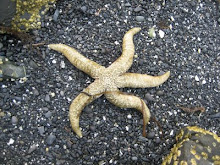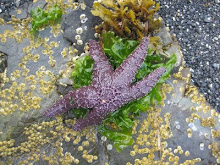This is a photo of the fishing vessel "Kimosabe" in Sitka Sound in Southeast Alaska.(approximately 1997) It is aground on a rock that most of the time is right under the surface. The rock is located in the middle of the channel between Middle Island and Little Gavanski Island. You can see some of the city of Sitka in the background.
When I first arrived in Sitka in 1995, a local took me out into the sound to show me the hazards and obstacles. They showed me how to navigate that particular area so that I would never hit that rock. I never did!
The tragic thing about the Kimosabe is that it hit the rock right before we had 10 days of extremely low tides. Normaly, if one went aground, one would wait for the tide to flow in and then drift off of the rock. In Sitka Sound there is one low tide and one high tide in a 24 hour period. When the moon is full the tides are more extreme because of the gravitiational force the Moon puts on the Earth. During that 10 day period the high tides were never high enough to allow the Kimosabe to drift off of the rock. In the photo, she's high and dry.
The crew of the Kimosabe lacked Local Knowledge. If they had obtained Local Knowledge they never would have gone aground.
Between 2000 and 2004, I delivered fifteen high-speed catamarans from Sitka, Alaska down to Vancouver BC, and then from Florida, up to New York City. I remember that some of the inlets leading in to the intercoastal waterway along the Florida coast said, " Do not enter this inlet without Local Knowledge".
All along the route, from Fort Lauderdale to New York City, we saw grounded vessels that had not received the proper Local Knowledge. The locals can tell you where the sandbars are located. They can tell you what part of the channel is the deepest. In life, as on the sea, Local Knowledge is important and many times indispensible.
Luckily, in my marine career, I never went hard aground. One time in Guam, I got too close to the edge of a channel when I was trying to pass a sailboat that was going down the middle of the channel because of its deep draft. I rubbed the prop on the bottom and marred the edge of the propellar on coral. We had to replace the prop.
All over the planet, the rusting hulks of grounded vessels dot the shoreline.
Note Sitka, Alaska in the background.
No navigational aid can take the place of Local Knowledge. In fact, all U.S. nautical charts have the following warning:
Warning
The prudent mariner will not rely solely on any single
aid to navigation, particularly floating aids.
Floating aids have long anchor chains connecting them to the bottom because of varying depths caused by ebbing and flowing tides. Thus, the aid is at a different location during low tide when the water is shallow. Don't just rely on a floating buoy.
If you rely only on a chart (map), and the chart is outdated, you may go aground.
The key is to use several different aids, Local Knowledge always being one of the most important.
I wrote the following poem in 2003 when delivering a high-speed ferry from Florida to New York where I counted 19 different grounded vessels.
May we navigate safely on the rough seas of life,
always having open ears to Local Knowledge is my prayer......
To my son Trevor,
and my grandson Jace,
who both love the sea!


























